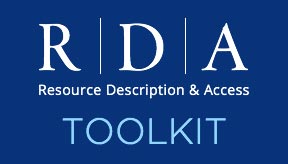Ongoing activities
Ongoing activities
There are a number of ongoing activities of the JSC that will be incorporated into the work on RDA.
-
Revised introductions
JSC has determined that the General Introduction to the code, as well as the Introductions to AACR2 parts I and II, will be significantly expanded to provide a conceptual background for the application of the rules. During 2002, CILIP/BL prepared drafts of the revised introductions, which were based on the existing text. In 2003, JSC decided that a completely new draft outline would be prepared.
The revised General Introduction will include information on the principles underlying the rules. A statement of objectives and principles is available:
-
RDA Objectives and Principles [PDF format]
The JSC has contributed to the creation of the IFLA Statement of International Cataloguing Principles
-
-
Reorganization of Part I
Beginning in 2003, the JSC considered proposals on ISBD areas 2, 3, 4, and 6 from the ALA Task Force on Consistency across Part I of AACR2. The Task Force examined the rules in part I to identify inconsistencies in wording across chapters, and instances where specific rules should be given in general form in chapter 1. The work to generalise rules by the Task Force fed into the work done by the Editor on RDA. The December 2004 draft of AACR3 part I consisted of chapters containing general rules, followed by chapters for supplementary rules applicable to specific types of content and media.
The constituency responses to the draft of part I expressed concerns regarding the separation between general and supplementary rules, and this was one factor in the decision at the April 2005 meeting to take a different approach to the arrangement of the new code.
-
GMDs and SMDs
The Joint Steering Committee has been faced with a number of issues concerning the future of the general material designation (GMD), particularly in the light of new types of materials and the increasing occurrence of mixed media. In order to give direction to this discussion, Barbara Tillett of the Library of Congress was asked to prepare a discussion paper on the history of the GMD in AACR2, the rationale for the use of GMDs, and possible choices for the future. This discussion paper was revised in May 2001, and was reviewed by the JSC constituents.
-
GMD Discussion Paper [PDF format]
At the September 2002 meeting, JSC asked the Format Variation Working Group to examine alternative ways of representing the GMD in bibliographic records. The Mode of Expression Subgroup did some preliminary work on deconstructing the GMD, and examining the use of form of expression identifiers.
At the April 2004 meeting JSC charged the Editor with examining GMDs and SMDs. The December 2004 draft of AACR3 part I included revised rules to permit in the GMD the use of either a content designation, or a medium designation, or both. The draft also included revised rules for specific material designations (SMDs). The constituency responses to the draft expressed a number of concerns regarding these proposals.
At the April 2005 meeting, the JSC decided to form a working group to propose terms for use in place of the current GMDs and SMDs. The JSC is also working with ONIX as part of the RDA and ONIX initiative to develop a common framework for resource categorization.
Drawing on the RDA/ONIX Framework and the terms proposed by the GMD/SMD Working Group, three new data elements, Media type (section 3.2), Carrier type (section 3.3) and Content type (section 4.2), are being proposed for RDA to assist users in fulfilling FRBR's “select” user task.
-
RDA Categorization of content and carrier [PDF format]
-
-
Chapter 21 including the Rule of three
As part of the new code, chapter 21 will be revised in light of the recommendations from Tom Delsey in part 2 of his Logical Structure of the Anglo-American Cataloguing Rules. This chapter will be the starting point for the relationships chapters of RDA.
Included in these chapters will be consideration of the Australian Committee on Cataloguing proposal (first issued in 2000) to make the limitations imposed by the rule of three optional.
Rule 21.29D currently allows for additional added entries to be made if required by cataloguers. -
Authority control
The current chapters 22-25 in AACR2 on form of heading will become the core of sections 2-4 and 9 of RDA, which will contain explicit instruction on providing authority control for access points in catalogues.
-
Incorporating FRBR terminology and concepts
At the October 2001 meeting, JSC decided that work should be conducted on incorporating terminology from the IFLA Functional Requirements for Bibliographic Records in AACR. Since that time, rule revisions have been proposed to ensure that the FRBR terms work, expression, manifestation, and item will be used in AACR in a manner consistent with their definitions in FRBR. The terms expression and manifestation are new to AACR. The term work is already used appropriately. However, the term item in AACR is not consistent with the FRBR definition. At the April 2004 meeting JSC charged the Editor with continuing the work to incorporate FRBR terminology and concepts.
At the April 2005 meeting, the JSC decided to align the structure of RDA more directly with the FRBR and FRAR (Functional Requirements for Authority Records, now Functional Requirements for Authority Data) models.
http://www.rda-jsc.org/rda.html
Last updated: 09 December 2010
Webmaster: JSC Secretary
